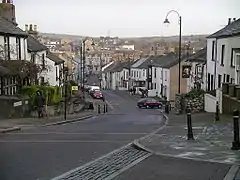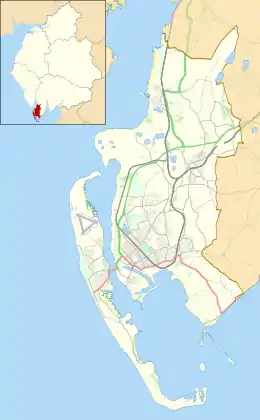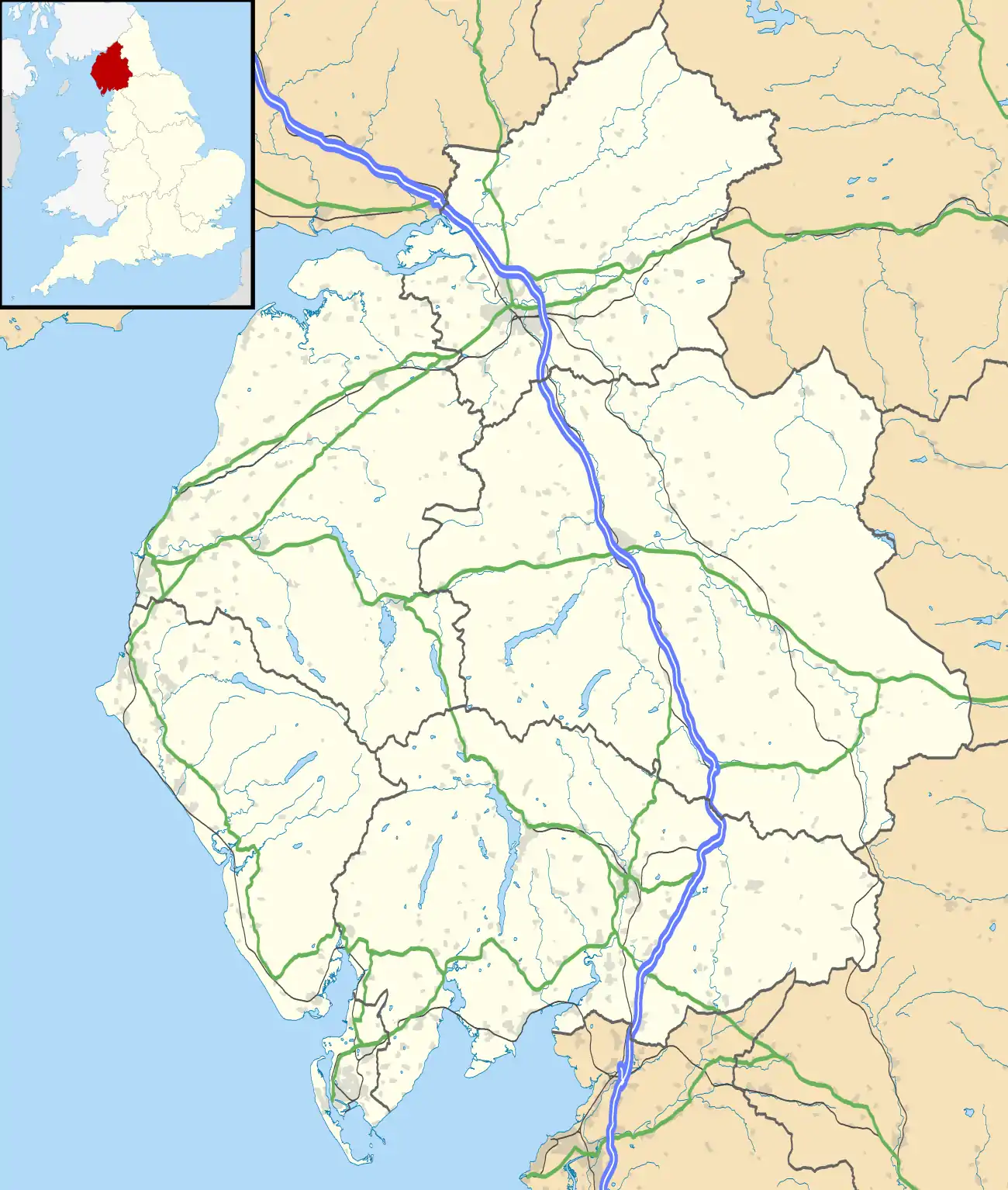Dalton-in-Furness
Dalton-in-Furness is a town in the Borough of Barrow-in-Furness, Cumbria, England. With a population of 8,125,[1] It is located north east of Barrow-in-Furness and is most noted for being the location of South Lakes Safari Zoo.
| Dalton-in-Furness | |
|---|---|
 Market Street, Dalton-in-Furness | |
 Dalton-in-Furness Location in Barrow-in-Furness Borough  Dalton-in-Furness Location within Cumbria | |
| Population | 8,125 (2011) |
| OS grid reference | SD228738 |
| Civil parish |
|
| District | |
| Shire county | |
| Region | |
| Country | England |
| Sovereign state | United Kingdom |
| Post town | DALTON-IN-FURNESS |
| Postcode district | LA15 |
| Dialling code | 01229 |
| Police | Cumbria |
| Fire | Cumbria |
| Ambulance | North West |
| UK Parliament | |
History
Dalton is mentioned in the Domesday Book, written as "Daltune" as one of the townships forming the Manor of Hougun held by Tostig Godwinson, Earl of Northumbria.[2] Historically, it was the capital of Furness. The ancient parish of Dalton covered the area which is now occupied by the Borough of Barrow-in-Furness. The town is now in the civil parish of Dalton Town with Newton. Historically a part of Lancashire, the town is associated with a number of famous artists, including George Romney
1929-2009 Dalton Community Association (DCA) is a registered Charity No. 1076322 Dalton Community Association (DCA) is housed in a building known locally as Dalton Drill Hall. The Drill Hall was officially opened in July 1929 as a Regular Army Centre for military training,and was used as a military headquarters in the years leading up to the war in 1939. During the war years (1939-1945) it was a centre for the Home Guard. It had a rifle range until 2009. After the war it was a Territorial and Army Cadet Headquarters. In addition the Drill hall was used as an annexe to Nelson Street Junior School. Since the early 1990s it has been used as a community and youth centre.
2009-2020 Dalton Community Association now run the building formerly known as Dalton Drill Hall. It is managed by the trustees who meet once a month to discuss the use and the upkeep of the building. Since the trustees have taken control of the building over £750,000 has been raised and spent on the property to modernise it and to build new rooms. The occupants include the police, who have an office in the front of the building which is very accessible to the public. Other groups using the building are Dalton Library, Rhythm Time, Yoga, Amplifon, Drop Zone, True Life Church, Connecting Mums, Furness Spiritualists, U3A, Army Cadets, Dalton Film Club and Age Concern.
Geography
The town is situated near the centre of Low Furness, on the eastern crest of a glaciated valley which runs obliquely across the peninsula. Just over a mile to the south lie the ruins of Furness Abbey, and four miles to the south west is the nearest major town, Barrow-in-Furness. The area is generally reached by the A590, the link road from the M6 motorway to the Furness region, which now by-passes the town, reducing the traffic flow, and enabling traffic calming measures which have proved to be rather controversial.
Dalton railway station, which serves the town, is located on the Furness Line, giving connections to Barrow, Ulverston, Grange-over-Sands and Lancaster. Also there are longer distance services to Preston and Manchester.

Dalton with Newton Town Council was the first corporate member of the Friends of Real Lancashire, an organisation dedicated to recognising the traditional county boundaries of Lancashire.
Sport
The local football teams Dalton United and Crooklands Casuals (also known as the Orangemen) play in the West Lancashire Football League. Dalton United were recently relegated from the Premier Division to division one and Crooklands Casuals promoted from Division One to the premier league cementing their position as number one club in the town.
Girls' and women's football in the town is provided by Dalton Girls and Ladies F.C. who have junior and open age teams competing in a various cumbrian leagues.
There is also a 2 junior football clubs, Crooklands Casuals boast the larger set up with teams from under 8s through to under 16s whilst, Dalton Junior F.C. provide mini league football (under 8s, under 9s and under 10s); Dalton JFC currently plays on Dowdales School fields.
Dalton Rugby League Football Club is located at the entrance to the town on Crooklands Brow. Currently in the first division of the North West Counties League. Their ground was recently renamed Kelland Park, in memory of Dalton rugby league stalwart, Ivor Kelland.
Dalton Cricket Club plays in the North Lancs. & Cumbria Cricket League. Dalton won the first organized cricket match played in Furness, beating Barrow. The Cricket Club also has many junior sides, such as The Under 11's & Under 13's. It also now has a table tennis club, located at the Seventh Day Adventist Church .
Education
Dowdales School is the town's secondary school with approximately 1,050 pupils. The school does not have a sixth form, but pupils transfer either to the Sixth Form College in Barrow, or to Barrow and Kendal Colleges of Further Education.
There are four primary schools in the town, Chapel Street School, George Romney Junior School, Dalton St Mary's Church of England Primary School and Our Lady of The Rosary Catholic School.
Attractions
In addition to being a quarter hour's journey from the boundary of the Lake District National Park, Dalton has a number of tourist attractions within its own borders, including:
Notable residents
In 1614 Margaret Fell (also known as Margaret Fox), founder of the Religious Society of Friends (Quakers), was born in Dalton with the birth name Askew. Known popularly as the "mother of Quakerism," she is considered one of the Valiant Sixty early Quaker preachers and missionaries. She died on 23 April 1702 at age 87 or 88.
Dalton was the birthplace and early home of George Romney in the 1700s, as well as Miles Romney in the early 1800s, the latter of whom is a direct ancestor of U.S. politician and former presidential candidate Mitt Romney.
William Ashburner (1737–1793), from Dalton-in-Furness, became the ancestor of a noted family of merchants and administrators in British-ruled India during company rule, the Ashburner family.[3]
Steve Dixon, Sky News presenter, was born in Newton-in-Furness, as was Richard T. Slone (b. 23 January 1974), an award-winning artist. Both were in the same year at school and were educated firstly in Newton and then in Dalton-in-Furness. Turner Prize winner Keith Tyson (b. 23 August 1969) grew up and attended school here as well.
E.B. Ford, an eminent scientist and author of the very popular New Naturalist book on butterflies, was born in Dalton in April 1901.
References
- "Civil Parish population 2011". Retrieved 25 January 2015.
- Cumbria: Hougun (The Domesday Book On-Line)
- Between Boston and Bombay: Cultural and Commercial Encounters of Yankees and Parsis, 1771–1865. Springer Nature. 2019. pp. 57–58. ISBN 9783030252052.
Further reading
- Battye, Rock (2006), Dalton-in-Furness : mediaeval capital to mining community, Pinner: Cumbrian Railways Association, ISBN 0-9540232-4-2
External links
| Wikimedia Commons has media related to Dalton-in-Furness. |
- http://www.daltoncommunityassociation.co.uk
- https://www.facebook.com/dalton-community-association-1667865086798665
- Dalton with Newton Town Council